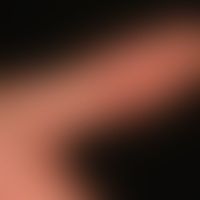Image diagnoses for "white"
207 results with 695 images
Results forwhite

Herpes simplex disseminatus B00.7
Herpes simplex infection: severe perirbital herpes simplex infection with secondary bacterial infection and numerous aberrant vesicles. herpetic infection of the lid margin. conjunctival injection.

Leprosy (overview) A30.9
Leprosy (overview): Borderlinelepromatous leprosy (BB), plaques and dome-shaped punch-out lesions.

Circumscribed scleroderma L94.0
Circumscribed scleroderma. Atrophy of the right leg muscles, atrophy of the gluteal muscles on the right, shortening of the right leg (difference 2.0 cm) with consecutive secondary pelvic obliquity and scoliosis in a 19-year-old female patient. Multiple white indurated plaques on the right leg are also present on the thighs, lower legs and in the foot area.

Nevus anaemicus Q82.5
naevus anaemicus: congenital, marginal irregularly dissected, white, smooth spots. no redness after rubbing the spot. on glass spatula pressure the borders to the surrounding area disappear. brown colored, intralesional melanocytic naevi (speaks against vitiligo!)

Scleronychia L60.83
Scleronychia: combined form of scleronychia with combined milky diffuse leukonychia, underlying circulatory disorder.

Tinea corporis B35.4
Tinea corporis. multiple, chronically active, grouped, 0.5-10.0 cm large (or larger), isolated and confluent, moderately to distinctly itchy, slightly rimmed, rough, scaly bright spots (and plaques). slow growth of single florets.

Hand-foot-mouth disease B08.4
Hand-foot-mouth disease. few, acute, painful, polygonal vesicles with a red courtyard. unspecific flu-like prodromies that had persisted about 2 weeks before.

Pityriasis versicolor (overview) B36.0
Pityriasis versicolor alba: vertical arrows mark the affected (depigmented) skin, encircling the normally tanned skin.

Ringworm B35.2
For a long time now, this large, "well-cared for", low-consistency, borderline, sometimes itchy plaque (interval-like local treatment with corticosteroids) has existed in the 42-year-old patient.

Herpes simplex recidivans B00.8
Herpes simplex recidivans: recurrent, in this case very extensive, multilocular herpes simplex infection in an HIV-infected person at intervals of 6-8 months

Pityriasis rosea L42
Pityriasis rosea: Extended upper body oriented less itchy exanthema with characteristic alignment in the cleft lines of the skin.

Idiopathic guttate hypomelanosis L81.5
Hypomelanosis guttata idiopathica: Disseminated, different sized, roundish, sharply defined, white patches on the lower leg of a 74-year-old patient; slight lesional scaling; solar lentigines.

Lichen planus mucosae L43.8
Lichen planus mucosae: small, white or opalescent spots and papules of the buccal mucosa, which condense into flat plaques at the end of the teeth, and which do not cause any significant discomfort.

Scleroderma and coup de sabre L94.1
scléroderma en coup de sabre: for years increasing symptomless furrow formation in the middle of the forehead. condition 7 years later. increasing furrowing of skin and skull bone.

Lichen planus mucosae L43.8
Lichen planus mucosae. cobblestone-like white or opal plaques of the buccal mucosa which condense at the end of the teeth. the mucosal changes have existed for 12 months and do not cause any significant discomfort.

Nevus melanocytic halo-nevus D22.L
Nevus, melanocytic, halo-nevus. solitary, depigmented, oval, sharply defined, smooth, white patch with central, sharply defined, brown, slightly raised papule. 27-year-old patient with multiple halo-nevi is shown here.

Flash lamps
Flashlamps (side effects of the therapy): streaky hypopigmentation after IPL depilation, hair growth unchanged







